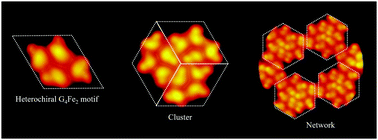当前位置:
X-MOL 学术
›
Phys. Chem. Chem. Phys.
›
论文详情
Our official English website, www.x-mol.net, welcomes your
feedback! (Note: you will need to create a separate account there.)
Hierarchical formation of Fe-9eG supramolecular networks via flexible coordination bonds†
Physical Chemistry Chemical Physics ( IF 2.9 ) Pub Date : 2018-01-05 00:00:00 , DOI: 10.1039/c7cp08278a Chi Zhang 1, 2, 3, 4, 5 , Lei Xie 1, 2, 3, 4, 5 , Yuanqi Ding 1, 2, 3, 4, 5 , Chunxue Yuan 1, 2, 3, 4, 5 , Wei Xu 1, 2, 3, 4, 5
Physical Chemistry Chemical Physics ( IF 2.9 ) Pub Date : 2018-01-05 00:00:00 , DOI: 10.1039/c7cp08278a Chi Zhang 1, 2, 3, 4, 5 , Lei Xie 1, 2, 3, 4, 5 , Yuanqi Ding 1, 2, 3, 4, 5 , Chunxue Yuan 1, 2, 3, 4, 5 , Wei Xu 1, 2, 3, 4, 5
Affiliation

|
From the interplay between high-resolution scanning tunneling microscopy imaging/manipulations and density functional theory calculations, we display the hierarchical formation of supramolecular networks by codeposition of 9eG molecules and Fe atoms on Au(111) based on the flexible coordination bonds (the adaptability and versatility in the coordination modes). In the first step, homochiral islands composed of homochiral G4Fe2 motifs are formed; and then in the second step, thermal treatment results in the transformation into the porous networks composed of heterochiral G4Fe2 motifs with the ratio of the components being constant. In situ STM manipulations and the coexistence of some other heterochiral G4Fe2 motifs and clusters also show the flexibility of the coordination bonds involved. These studies may provide a fundamental understanding of the regulations of multilevel supramolecular structures and shed light on the formation of designed supramolecular nanostructures.
中文翻译:

Fe-9eG超分子网络通过柔性配位键的分层形成†
从高分辨率扫描隧道显微镜成像/操作与密度泛函理论计算之间的相互作用,我们基于9eG分子和Fe原子在Au(111)上的共配键(基于柔性配位键(适应性和协调模式的通用性)。第一步,形成由同手性G 4 Fe 2基序组成的同手性岛。然后在第二步中,热处理导致转变成由异手性G 4 Fe 2基序组成的多孔网络,其组分的比例恒定。原位STM操作和其他一些杂手性G的共存4个Fe 2基序和簇也显示了所涉及的配位键的灵活性。这些研究可能为多级超分子结构的调控提供基本的了解,并为设计超分子纳米结构的形成提供启示。
更新日期:2018-01-05
中文翻译:

Fe-9eG超分子网络通过柔性配位键的分层形成†
从高分辨率扫描隧道显微镜成像/操作与密度泛函理论计算之间的相互作用,我们基于9eG分子和Fe原子在Au(111)上的共配键(基于柔性配位键(适应性和协调模式的通用性)。第一步,形成由同手性G 4 Fe 2基序组成的同手性岛。然后在第二步中,热处理导致转变成由异手性G 4 Fe 2基序组成的多孔网络,其组分的比例恒定。原位STM操作和其他一些杂手性G的共存4个Fe 2基序和簇也显示了所涉及的配位键的灵活性。这些研究可能为多级超分子结构的调控提供基本的了解,并为设计超分子纳米结构的形成提供启示。











































 京公网安备 11010802027423号
京公网安备 11010802027423号